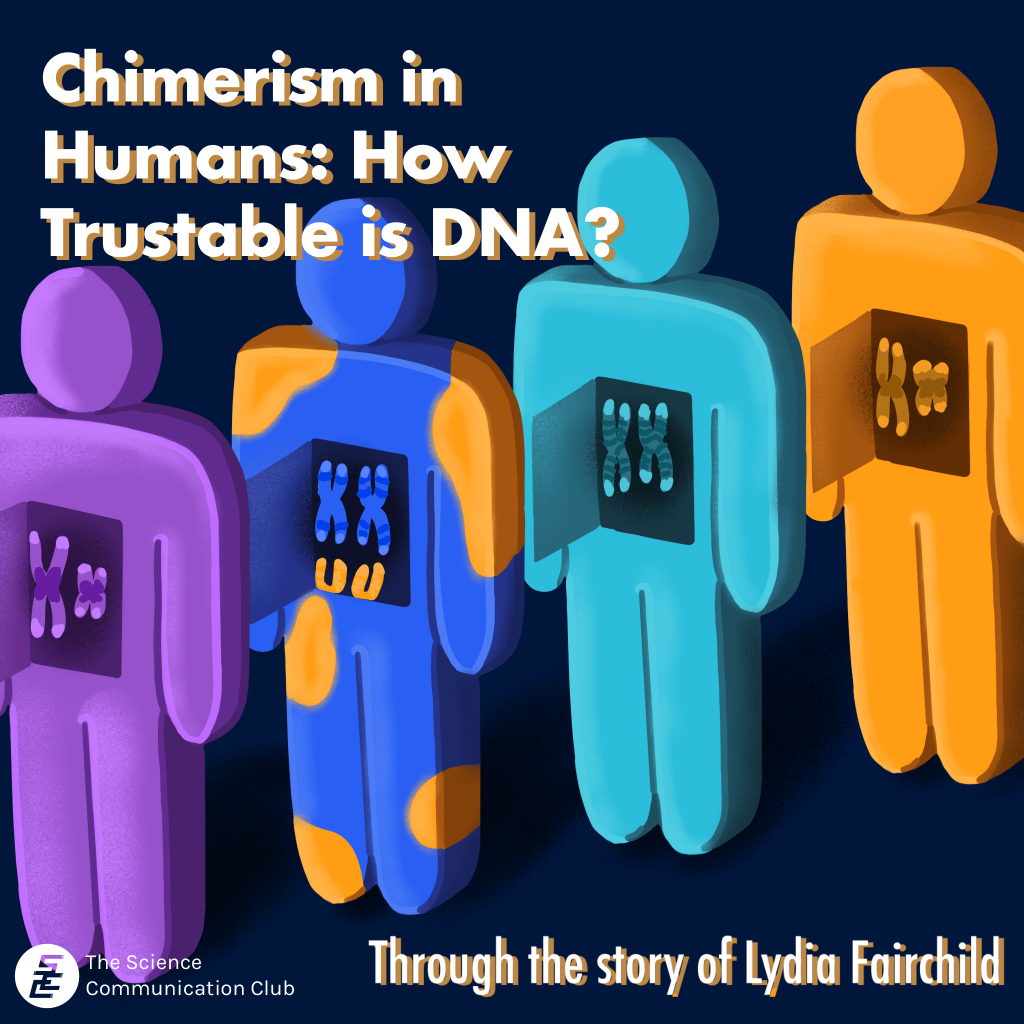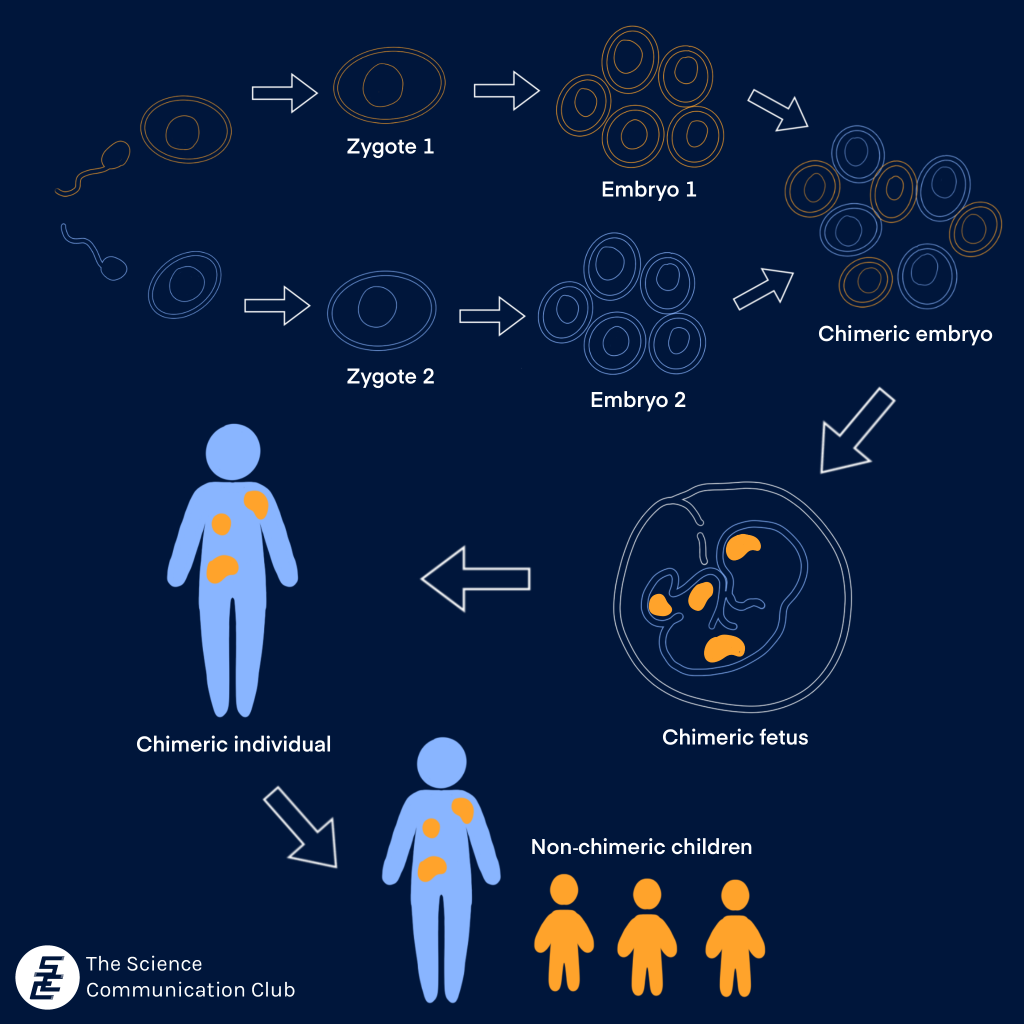
Written by Selin Eda Sagnak
Illustrated by Juliet Ko
DNA is a unique biological molecule often referred to as the building block of life. In today’s society, identification of organisms or their relationships depends on DNA: For instance, determining someone’s identity from forensic evidence or conducting blood relation tests relies on an individual’s unique DNA sequence. This connection can be seen in our lives in situations like court cases and even as common as television shows! We trust the certainty of DNA to guide us in times of uncertainty.
But have you ever thought that DNA could be lying…Or tricking us?
Chimerism is a biological condition resulting from abnormalities in fertilization of eggs and sperm during reproduction. It can cause affected children to have a combination of DNA from two separate embryos!1 Sometimes, this is called a “vanishing twin” during pregnancy.2 Vanishing Twin Syndrome refers to the phenomenon where one of the twins formed during fertilization disappears as the pregnancy proceeds.3 The two twins fuse into a single individual during pregnancy causing genetic material from two separate eggs or sperm to be present in different parts of their body. For example, some individuals have a genetically distinct line of cells present in their reproductive tissue.4 In this case, DNA isn’t always a good indicator of identity, because it can be very different in various body parts!

One example is Lydia Fairchild, who certainly didn’t expect to almost lose her children as a result of a maternity test.4 In order to obtain childcare funds from the government, Fairchild tried to prove she was the biological mother of the children, but, DNA test results indicated otherwise!4 This caused government officials to investigate Fairchild’s intentions for obtaining state assistance and they even sent her to court due to the suspicious genetic evidence.4 After numerous DNA tests, and even observing Fairchild give birth to her third child -who also tested negative for maternal relationship-, the court still concluded that Fairchild had committed fraud!4 Although this case seemed impossible to solve, a lawyer named Alan Tindell took interest after seeing the 3rd child’s DNA results. Through his research, he discovered an article about a woman named Karen Keegan who had chimerism.4 Considering this newly emerging evidence, the DNA tests were repeated with samples from different body parts of Fairchild, and yet continued to show negative results, until a sample was taken from her reproductive tissue, which indicated that she was the biological mother of her children.4 The case was resolved after this new discovery, but it has sparked debate on whether we can rely on DNA evidence. Scientists are divided: some believe that the commonness of chimerism in humans causes DNA evidence to be inherently faulty, while others consider its effects to be small in relation to the overall reliability of DNA as an identification tool.
Regardless of which perspective holds true, one thing is for certain: DNA can be misleading in specific instances. The case of Karen Keegan was published very recently, in the same year as Fairchild’s trial.4 One cannot stop themselves from imagining the outcome for Lydia Fairchild if this evidence hadn’t come to light! Fairchild’s case has shown how not everything in science is true 100% of the time, and a single rare event can raise an important question: how much do we truly know about ourselves?
Sources:
- Draper NL, editor. Chimerism. Cham: Springer International Publishing; 2018. http://link.springer.com/10.1007/978-3-319-89866-7. doi:10.1007/978-3-319-89866-7
- de bellefon LM, Heiman P, Kanaan SB, Azzouz DF, Rak JM, Martin M, Roudier J, Roufosse F, Lambert NC. Cells from a vanished twin as a source of microchimerism 40 years later in a male with a scleroderma-like condition. Chimerism. 2010;1(2):56–60. doi:10.4161/chim.1.2.14294
- Segal NL. Oliver Sacks: Our Correspondence About Twins/Twin Research: Vanishing Twins Syndrome; Discordant Sex in MZ Twins; Pregnancy Outcomes in IVF and ICSI Conceived Twins/Print and Media: Superfetated Twins; Twins Discordant for Smoking; Twins in Fashion; Yale University Twin Hockey Players; Conjoined Twin–Visiting Professor. Twin Research and Human Genetics. 2017;20(4):363–369. doi:10.1017/thg.2017.34
- Darby A. The Case of Lydia Fairchild and Her Chimerism (2002). In: The Embryo Project Encyclopedia. 2021. https://embryo.asu.edu/pages/case-lydia-fairchild-and-her-chimerism-2002
- About Program Income and Public Assistance. United States Census Bureau. 2022 Oct 3. https://www.census.gov/topics/income-poverty/public-assistance/about.html